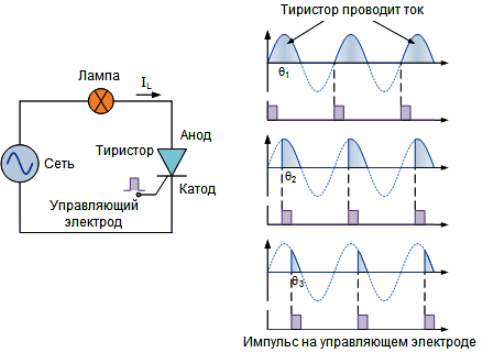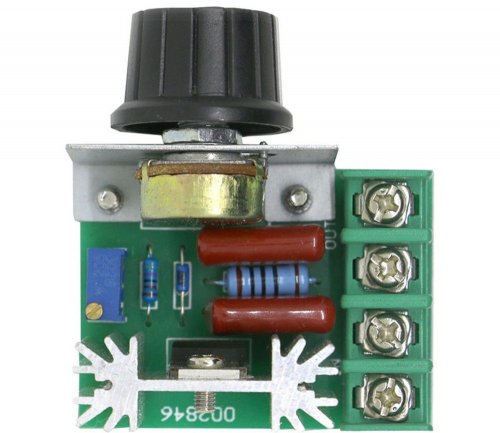The principle of power regulation in an alternating current load using thyristors
The average load power in sinusoidal AC circuits can be adjusted by thyristors… This method of controlling power consumption is particularly easy if the load is purely active. However, with some modifications to consumer circuits, it is possible to control loads using thyristors. reactive component.
This approach to regulation is commonly called phase voltage regulation, and is generally applied to such consumers who can initially be powered directly from the grid, but do not require perfectly harmonic tension form.
The control principle is to change the opening angle of the thyristor like an electronic switch. So, when the thyristor opens and conducts current not through the entire half-wave of the sine wave, but only starting from a certain phase of it, incomplete sine waves are fed to the load and their pieces with the initial part of the half-month cycle cut off.
This is achieved by the fact that the thyristor or works as an independent half wave rectifier, or two thyristors are included in the rectifier circuit (then this is the so-called controlled rectifier). The result of the operation of the circuit is a reduction in the effective value of the voltage supplied to the load, which is connected after such a rectifier.

Such circuits can often be found in soft starters of DC motors, on boards for controlling the current of rechargeable batteries, in devices for adjusting the brightness of incandescent lamps, etc.
The advantage of this approach is primarily in the low cost and simplicity of assembling circuits with thyristors, as well as in the simplicity of control circuits for phase regulation of voltage when it comes to alternating current in the network. The disadvantage, of course, is the distorted shape of the resulting voltage, a high ripple current at the output and a reduction in the user's power factor.
The essence of the disadvantage associated with the distortion of the voltage and current shape is that when the thyristor is suddenly turned off, the current through the load increases sharply, while the voltage drop across the resistances in both the supply circuit and the load circuits increases sharply. The shape of the supply voltage does not become sinusoidal at all. We need to build additional filters when it comes to, say, controlling the power of an induction motor, for which pure sine is always desired.
The thyristor is designed in such a way that it begins to conduct current as a diode starting exactly from the moment the trigger voltage pulse is applied to its control electrode.At this moment, the thyristor switches from the locked state to the conducting state and conducts current from the anode to the cathode, even if the action of the control pulse has already ended, but the current from the anode to the cathode continues to flow.
As soon as the current in the circuit stops, the thyristor locks up and waits for the next pulse to its control electrode while the voltage is applied from the anode side. Thus, the periods of the open state of the thyristor are formed and the cut pieces of the current sinusoid in the user circuit are obtained.
For this reason, thyristor control is widely used in household electrical appliances, where heating elements, DC motors, filaments are used - such devices that are not particularly sensitive to waves occurring at the frequency of the network. Small, compact and inexpensive thyristor dimmers are ideal for adjusting the temperature of electric underfloor heating, the intensity of the glow of incandescent lamps, the temperature of oil heaters, soldering irons, etc.
See also:Principles of thyristor and triac control

